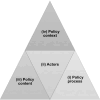Comparative study on school-based mental health literacy in three Asian countries
- PMID: 40551284
- PMCID: PMC12183912
- DOI: 10.1186/s41182-025-00697-6
Comparative study on school-based mental health literacy in three Asian countries
Abstract
Introduction: Mental health literacy is essential for the recognition, management, and prevention of mental disorders among school-aged children. However, few studies have examined the implementation status of school-based mental health literacy in Asian countries. This study aims to compare the approaches taken by the Philippines, Indonesia, and Japan in managing school-based mental health literacy through curriculum-related policies.
Methods: The collected documents of this study analyzed both policies (formulated from 2000 to 2023) and curricula (from grade 1 to grade 12) that were adapted to the deductive content analysis methods. Policies were analyzed using the policy triangle framework (Walt and Gilson in Health Policy Plan 9:353-370, 1994) and mapped using the review points (Margaretha et al. in Front Psychiatry 14:1126767, 2023). Curricula were analyzed using the definition of mental health literacy (Jorm in Am Psychol 67:231-243, 2012). This study focused on mental health laws and policies in the Philippines, Indonesia, and Japan, highlighting their success in addressing the needs of adults and school-aged children. By considering each country's unique socio-cultural contexts and basic educational approaches, this study identified diverse strategies and methodologies in addressing mental health challenges. Using a common analytic framework, this study collected and analyzed policies and curricula on mental health literacy from the three countries (Philippines, 22; Indonesia, 9; and Japan, 6). The basic education curricula developed by their respective Ministries of Education were used.
Results: This study highlights two key findings on school-based mental health literacy. First, mental health literacy is incorporated into health and physical education in Japan, health, values education and homeroom guidance in the Philippines, and religious education in Indonesia. Second, while the Philippines and Indonesia implement mental health education based on established policies, Japan lacks a core mental health literacy policy but has developed and implemented related curricula through its course of study guidelines. The curriculum analysis identified a specific challenge: a lack of "first aid skills to support others who are developing a mental disorder or are in a mental health crisis".
Conclusions: This study revealed the partial implementation of mental health literacy education in the Philippines, Indonesia, and Japan. The Philippines offers a nearly comprehensive curriculum on mental health literacy (grades 1-12), Japan incorporates it into health education (grades 5-10), and Indonesia integrates it into religious education (grades 1-12). While the Philippines and Indonesia align with mental health policies, Japan relies on its national curriculum without a core policy. A key challenge was indicated involving teachers, guidance counselors, or school health personnel as key actors to support students with mental disorders or those potentially at risk, as well as to handle emergency cases of mental disorders in schools. Recommendations include systematic monitoring of the implementation of school-based mental health policies, collaboration with UN agencies to align with international standards while incorporating culturally tailored strategies for each country.
Keywords: Asia; Comparative study; Curriculum; Mental health literacy; Policy; Schools.
© 2025. The Author(s).
Conflict of interest statement
Declarations. Ethics approval and consent to participate: Not applicable. Consent for publication: Not applicable. Competing interests: The authors declare no competing interests.
Figures
Similar articles
-
Feasibility study of Learning Together for Mental Health: fidelity, reach and acceptability of a whole-school intervention aiming to promote health and wellbeing in secondary schools.Public Health Res (Southampt). 2025 Jun 18:1-36. doi: 10.3310/RTRT0202. Online ahead of print. Public Health Res (Southampt). 2025. PMID: 40542530
-
Home treatment for mental health problems: a systematic review.Health Technol Assess. 2001;5(15):1-139. doi: 10.3310/hta5150. Health Technol Assess. 2001. PMID: 11532236
-
Strategies for enhancing the implementation of school-based policies or practices targeting risk factors for chronic disease.Cochrane Database Syst Rev. 2017 Nov 29;11(11):CD011677. doi: 10.1002/14651858.CD011677.pub2. Cochrane Database Syst Rev. 2017. Update in: Cochrane Database Syst Rev. 2022 Aug 29;8:CD011677. doi: 10.1002/14651858.CD011677.pub3. PMID: 29185627 Free PMC article. Updated.
-
Measures implemented in the school setting to contain the COVID-19 pandemic.Cochrane Database Syst Rev. 2022 Jan 17;1(1):CD015029. doi: 10.1002/14651858.CD015029. Cochrane Database Syst Rev. 2022. Update in: Cochrane Database Syst Rev. 2024 May 2;5:CD015029. doi: 10.1002/14651858.CD015029.pub2. PMID: 35037252 Free PMC article. Updated.
-
Cost-effectiveness of using prognostic information to select women with breast cancer for adjuvant systemic therapy.Health Technol Assess. 2006 Sep;10(34):iii-iv, ix-xi, 1-204. doi: 10.3310/hta10340. Health Technol Assess. 2006. PMID: 16959170
References
-
- World Health Organization Regional Office for the Western Pacific. Regional framework for the future of mental health in the Western Pacific 2023–2030. Manila: World Health Organization Wester Pacific Regional Office; 2023. https://www.who.int/westernpacific/publications/i/item/9789290620075. Accessed 6 Dec 2024.
-
- World Health Organization. Mental Health and COVID-19: Early evidence of the pandemic’s impact: Scientific brief, 2 March 2022. Geneva: World Health Organization; 2022. https://www.who.int/publications/i/item/WHO-2019-nCoV-Sci_Brief-Mental_h.... Accessed 6 Dec 2024.
-
- Tanaka T, Okamoto S. Increase in suicide following an initial decline during the COVID-19 pandemic in Japan. Nat Hum Behav. 2021;5:229–38. - PubMed
Grants and funding
LinkOut - more resources
Full Text Sources

